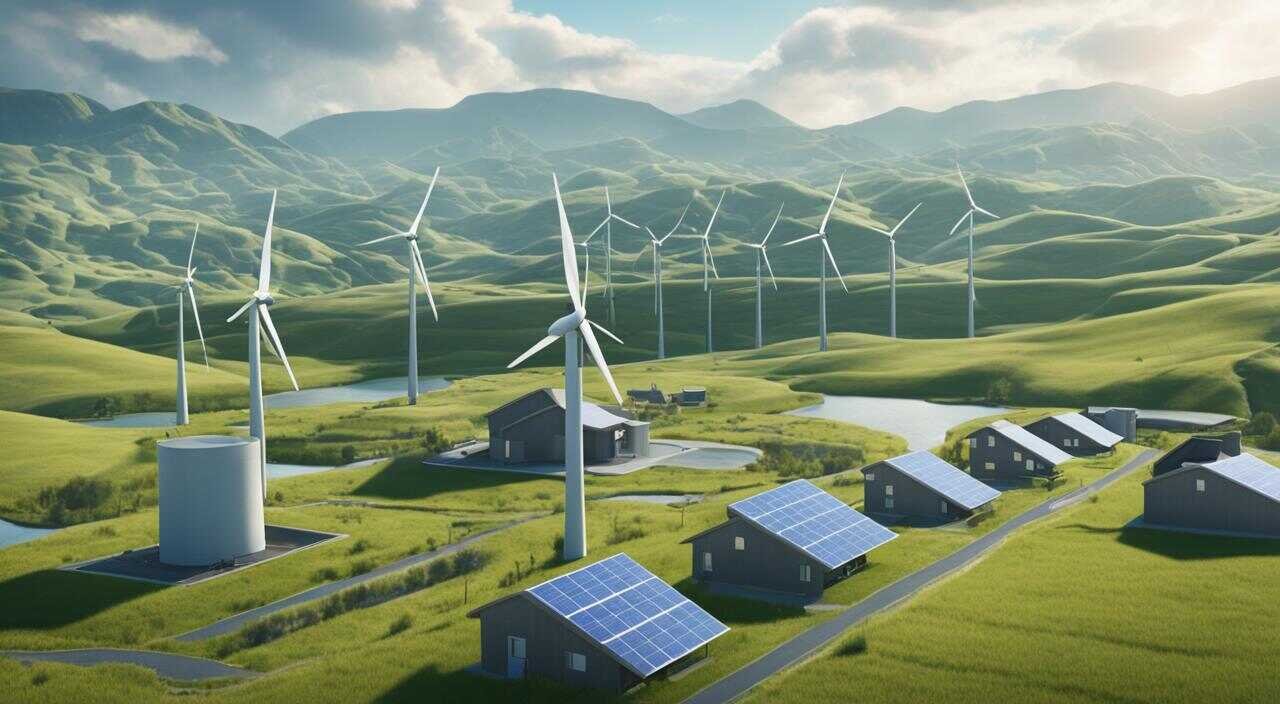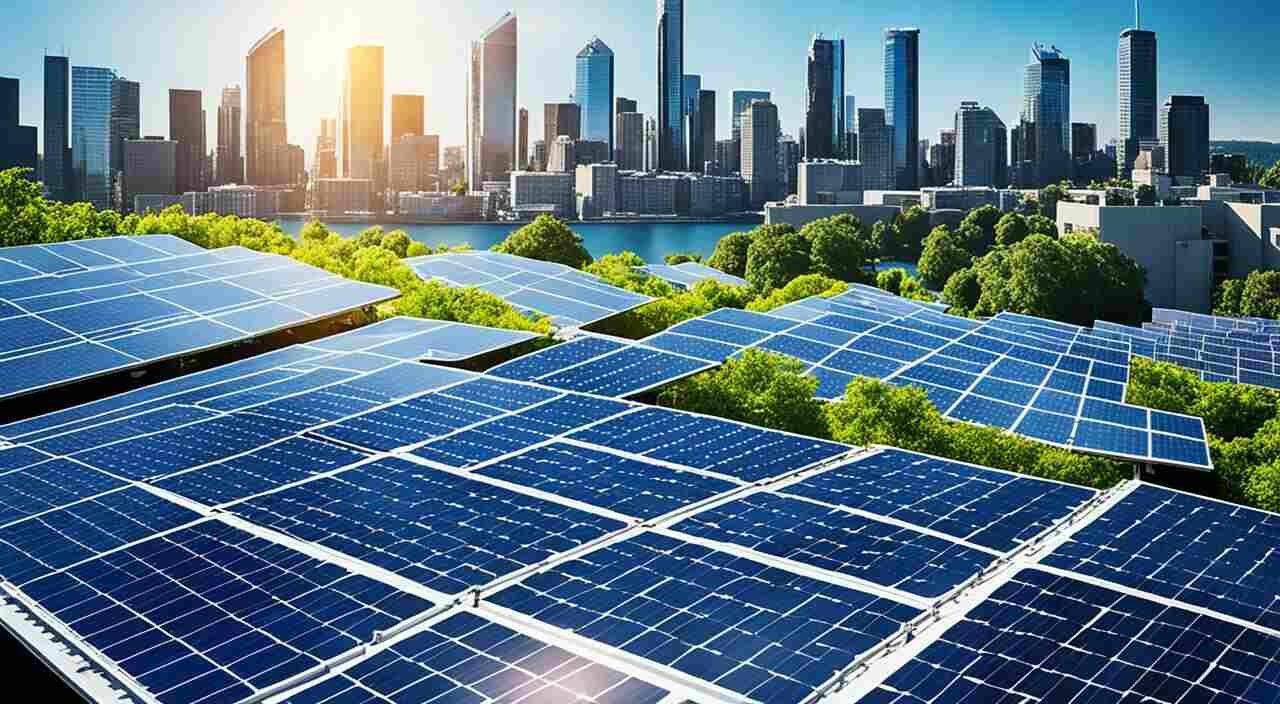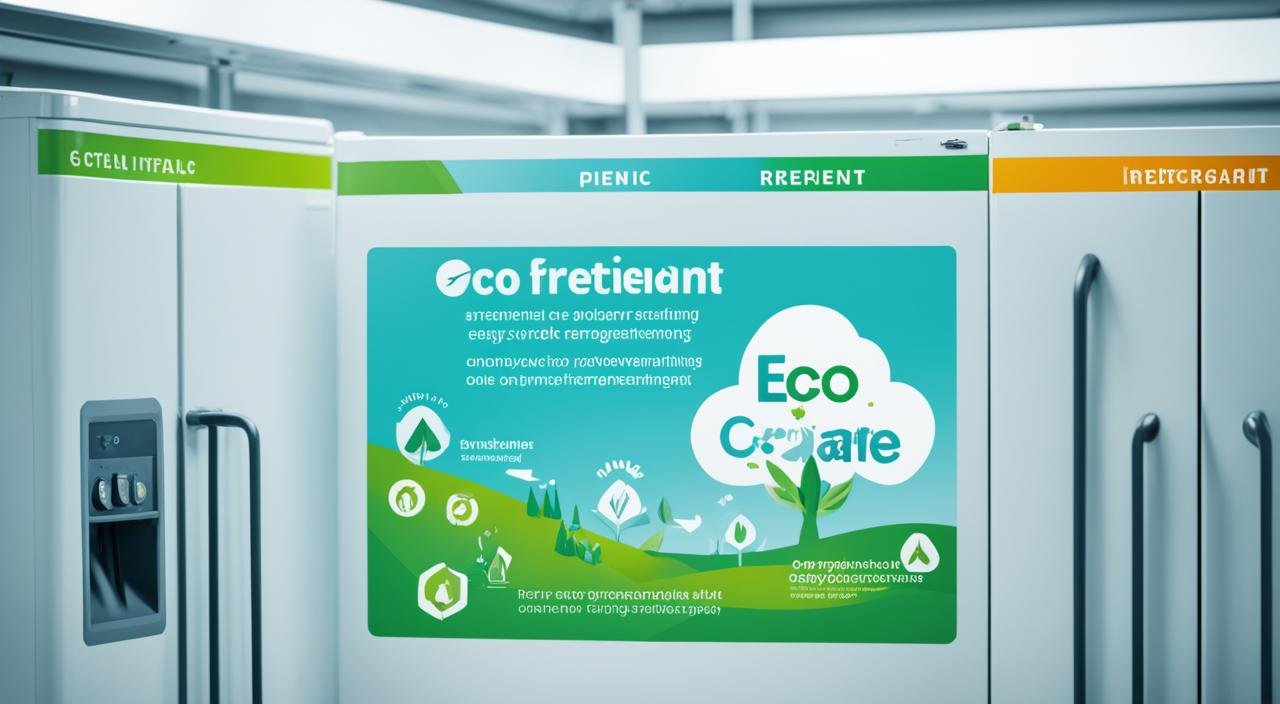Welcome to our article on renewable resource examples, where we explore the fascinating world of eco-friendly energy sources. As the global demand for energy continues to rise, finding sustainable alternatives to fossil fuels is crucial for the health of our planet and future generations. In this article, we will showcase various renewable energy sources and their benefits, highlighting how they contribute to a greener and more sustainable future.
Key Takeaways:
- Solar energy, wind power, hydropower, geothermal energy, and biomass are examples of renewable resources.
- Renewable energy sources are constantly being replenished and do not deplete over time.
- Transitioning from non-renewable to renewable resources is essential for addressing the climate crisis.
- Renewable energy is now more affordable and provides more job opportunities than fossil fuels.
- Renewable resources offer numerous benefits, including unlimited availability and reduced emissions of harmful pollutants.
Benefits of Renewable Energy
Renewable energy sources offer a wide range of benefits that make them an attractive alternative to non-renewable energy sources. These benefits include:
“Renewable energy is the future of sustainable and eco-friendly energy.”
Unlimited and Sustainable
Renewable energy sources, unlike non-renewable ones, are essentially unlimited and won’t run out over time. This means that we can rely on these resources for a long-term and sustainable energy supply. By harnessing the power of natural elements that constantly renew themselves, such as sunlight and wind, we reduce our reliance on finite resources and ensure a greener future for generations to come.
Environmental Benefits
Switching to renewable energy sources has significant health and environmental benefits. Unlike fossil fuels, renewable energy does not produce harmful emissions or pollutants that contribute to air and water pollution and climate change. By embracing renewable energy, we can mitigate the negative impacts of traditional energy sources and reduce our carbon footprint.
Stability in Energy Prices
Renewable energy sources provide stability in energy prices. Unlike fossil fuels, which are subject to price fluctuations driven by geopolitical tensions and limited supply, renewable resources are not affected by worldwide energy price fluctuations. This stability contributes to a more predictable and affordable energy market, benefiting both consumers and businesses alike.
Examples of Renewable Resources in Everyday Life
In everyday life, we can find several examples of renewable resources that are widely used and easily accessible. These include:
- Solar energy: Harnessing the power of the sun’s rays, solar energy can be used to generate electricity for homes and businesses and to provide hot water.
- Wind power: By capturing the kinetic energy of the wind with wind turbines, we can generate electricity on both small and large scales.
- Hydropower: The movement of flowing or falling water, such as rivers or waterfalls, can be harnessed to generate clean and renewable energy.
- Geothermal energy: Utilizing the Earth’s heat, geothermal energy can be used for heating and electricity generation.
- Biomass: Organic plant and animal matter can be converted into biofuels or burned directly to produce heat and electricity.
Solar Energy
The power of the sun is harnessed through solar energy, which can be captured by solar panels. This clean and renewable resource offers a wide range of applications, from generating electricity for homes and businesses to charging battery systems and producing hot water. Solar energy is abundant and widely available, making it a popular choice for harnessing renewable power.
Solar power is a sustainable solution with numerous advantages. It reduces reliance on traditional energy sources and helps combat climate change by reducing greenhouse gas emissions. As advancements in technology continue to improve the efficiency and affordability of solar panels, more and more people are turning to solar energy as a viable alternative.
By harnessing the power of the sun, solar panels provide a clean and reliable source of electricity. Whether it’s residential rooftops or large-scale solar farms, solar energy is transforming the way we power our world. Let’s take a look at some examples of solar energy in action:
- Solar-powered homes and businesses: Photovoltaic (PV) systems installed on rooftops convert sunlight into electricity, reducing reliance on the grid and lowering energy costs.
- Solar-powered streetlights: Streetlights equipped with solar panels and batteries can provide efficient illumination without the need for traditional power sources.
- Solar-powered water heaters: Solar thermal systems use sunlight to heat water for residential and commercial use, reducing the need for conventional heating methods.
The versatility and potential for solar energy applications are vast, offering a sustainable solution to meet our energy needs. As the demand for clean and renewable energy continues to grow, solar power plays a critical role in creating a greener and more sustainable future.
Wind Power
Wind power is a renewable energy source that harnesses the movement of air within the Earth’s atmosphere to generate electricity. Wind turbines are used to capture the power of the wind and convert it into a usable form of energy.
Wind power has gained popularity in recent years due to its clean and sustainable nature. It offers several advantages over traditional fossil fuel-based power generation methods.
Wind power is a clean and renewable resource that is growing in popularity.
One of the key benefits of wind power is its cost-effectiveness. Once a wind farm is installed, the operational costs are relatively low, making it an economically viable option for generating electricity. Additionally, wind power is becoming increasingly efficient, allowing for greater energy production from the same amount of wind.
Another advantage of wind power is its contribution to reducing greenhouse gas emissions. Unlike fossil fuel-based power generation, wind power does not produce harmful pollutants that contribute to air pollution and climate change. By relying on wind energy, we can reduce our carbon footprint and mitigate the impacts of global warming.
Furthermore, wind power is a versatile energy source that can be harnessed both onshore and offshore. Onshore wind farms are typically located in open areas with high wind speeds, while offshore wind farms take advantage of strong coastal winds. This versatility allows for the efficient utilization of wind power in various geographical locations.
Wind Energy Examples
- Large-scale wind farms that generate electricity for communities and cities
- Small-scale wind turbines used to power individual homes or businesses
- Hybrid wind-solar systems that combine the benefits of both renewable energy sources
Overall, wind power is a sustainable and environmentally friendly solution for meeting our energy needs. With ongoing advancements in wind turbine technology and increasing investment in wind energy infrastructure, we can continue to harness the power of the wind and transition to a cleaner, greener future.
Hydropower
Hydropower, also known as hydroelectricity, is generated from the movement of flowing or falling water. It is a significant contributor to renewable energy and plays a crucial role in reducing greenhouse gas emissions. Hydropower is commonly harnessed at large dams or waterfalls, where the water drops significantly in elevation, allowing for the efficient capture of energy.
One of the key advantages of hydropower is its ability to provide a consistent and reliable source of electricity. Unlike solar or wind energy, which are dependent on weather conditions, hydropower can generate electricity consistently, making it ideal for meeting base-load demand.
In addition to large-scale hydropower plants, there are other forms of hydropower that can be utilized. These include tidal power, which harnesses the energy of the ocean tides, and wave power, which captures the energy of ocean waves. These forms of hydropower have immense potential for sustainable energy generation, especially in coastal areas.
While hydropower is considered a clean and renewable resource, it is important to acknowledge its environmental impact. The construction of large dams can lead to the displacement of communities and have significant ecological consequences. The alteration of natural river systems can disrupt fish migration patterns and affect wildlife habitats.
Despite these concerns, advancements in hydropower technology have aimed to minimize its negative impacts. For example, fish ladders and fish bypass systems are implemented to facilitate fish migration, and environmental impact assessments are conducted to ensure responsible project development.
In conclusion, hydropower is a valuable source of renewable energy that utilizes the power of flowing or falling water to generate electricity. While it has a greater environmental impact compared to some other renewable energy sources, careful planning and responsible implementation can help mitigate these effects. Hydropower, along with other renewable resources, plays a crucial role in transitioning to a more sustainable energy future.
| Advantages of Hydropower | Disadvantages of Hydropower |
|---|---|
| 1. Clean and renewable energy source | 1. Environmental impact from dam construction |
| 2. Consistent and reliable source of electricity | 2. Displacement of communities |
| 3. Can provide base-load power | 3. Disruption of aquatic ecosystems |
| 4. Potential for additional forms of hydropower (tidal power, wave power) | 4. Limited availability of suitable locations |
Geothermal Energy
Geothermal energy is an abundant and sustainable source of power that harnesses the natural heat from the Earth’s core. This renewable energy resource is derived from the heat trapped during the planet’s formation and the radioactive decay in rocks deep beneath the Earth’s crust. Unlike other renewable energy sources like solar or wind power, geothermal energy is available 24/7, making it a reliable and constant source of electricity and heating.
Geothermal power plants tap into the natural heat reservoirs found underground to generate electricity. These plants use geothermal wells to pump hot water or steam from deep within the Earth to drive turbines, thus converting the thermal energy into electrical energy. The resulting power can be used to meet the electricity needs of residential, commercial, and industrial sectors.
Geothermal power is a reliable and renewable energy source that provides a sustainable solution for meeting our energy demands. With its consistent availability and low environmental impact, geothermal energy contributes to reducing greenhouse gas emissions and combating climate change.
There are several notable examples of geothermal energy applications worldwide. One significant example is The Geysers, located in California’s Sonoma and Lake Counties, which is the largest geothermal power production site in the world. This geothermal complex utilizes steam resources to generate over 900 megawatts of electricity, providing clean energy to millions of households and industries in the region.
Another example is the Hellisheiði Power Station in Iceland, a pioneering geothermal project that showcases the country’s commitment to sustainable energy. The power station combines geothermal heat and steam to produce electricity and hot water for heating purposes, supporting Iceland’s goal of becoming carbon-neutral by 2040.
Furthermore, geothermal energy can also be used for direct heating and cooling applications. Geothermal heat pumps utilize the steady temperatures below the surface to efficiently heat and cool buildings, reducing the reliance on fossil fuel-based systems and lowering energy costs.
Geothermal energy’s versatility and environmental benefits make it a valuable resource for achieving a sustainable energy future. With ongoing advancements in technology and increased investments in geothermal projects, this renewable energy source has the potential to play a significant role in reducing greenhouse gas emissions and fostering energy independence.
| Advantages | Challenges |
|---|---|
| Renewable and sustainableAvailability 24/7Low greenhouse gas emissionsMinimal land disturbanceLong operational lifespan | Site-specific resource potentialHigh initial drilling costsGeographical limitationsCorrosion issuesLimited to certain regions |
Biomass Energy
Biomass energy is an essential form of renewable energy that harnesses the power of organic plant and animal matter. It plays a significant role in reducing greenhouse gas emissions and diversifying our energy sources. Biomass fuels can be derived from various sources, including agricultural residues, dedicated energy crops, and wood waste. Let’s explore how biomass energy is used and its potential examples.
Direct Combustion
One of the primary methods of utilizing biomass energy is through direct combustion. Biomass fuels such as wood pellets, agricultural residues, and urban waste can be burned to produce heat. This heat can then be used for a variety of purposes, including heating buildings, generating steam for industrial processes, or even generating electricity through steam turbines.
Biofuels
Biomass can also be converted into biofuels like ethanol and biodiesel, which serve as alternatives to traditional fossil fuels. These biofuels can be blended with gasoline or diesel and used in vehicles without any modifications. Additionally, biofuels can be beneficial in reducing emissions and promoting energy independence.
Examples of Biomass Energy
There are several noteworthy examples of biomass energy applications:
- Biogas plants utilize organic waste from farms, households, and industries to produce biogas, which can then be used for heating or generating electricity.
- Forest residues, such as branches, bark, and sawdust, can be converted into wood pellets or chips for use in biomass power plants.
- Energy crops, like switchgrass and miscanthus, can be grown specifically for energy production, providing a sustainable source of biomass fuel.
Biomass energy is a traditional and widely used renewable resource. It offers numerous benefits, including mitigating climate change, reducing dependence on fossil fuels, and supporting local economies through the creation of jobs in the biomass industry.
Non-Renewable Energy Sources
Error: Section 8 not provided.
Conclusion
Renewable resources examples provide a sustainable solution for our energy needs. They offer numerous benefits, including unlimited availability, health benefits, and independence from fluctuating fuel prices. Transitioning from non-renewable energy sources to renewable resources is crucial for addressing the climate crisis and creating a greener and more sustainable future.
Solar energy is a prime example of a renewable resource that is widely used. By harnessing the power of the sun, solar panels generate clean electricity for homes and businesses. Wind power, another renewable resource, utilizes wind turbines to convert the energy of the wind into electricity. Hydropower, obtained from the movement of flowing or falling water, is a significant contributor to renewable energy.
Geothermal energy, derived from the Earth’s heat, and biomass energy, generated from organic plant and animal matter, are also examples of sustainable resources. The transition to using these renewable resources is not only necessary for reducing greenhouse gas emissions, but also for creating a more resilient and self-sufficient energy system that can withstand fluctuating fuel prices and supply disruptions.
As we continue to explore and embrace the potential of renewable resources, we move closer to a cleaner and more sustainable future. By investing in solar energy, wind power, hydropower, geothermal energy, and biomass, we can reduce our dependence on finite and polluting fossil fuels. Let us embrace the power of renewable resources and work together towards a sustainable and thriving planet.
FAQ
What are renewable resources?
Renewable resources are derived from natural sources that are replenished at a higher rate than they are consumed. They include sunlight and wind, among others.
Why is it important to transition to renewable energy sources?
Transitioning from non-renewable fossil fuels to renewable energy sources is vital for addressing the climate crisis. Renewable resources are unlimited, have numerous health benefits, and are less sensitive to energy price fluctuations.
What are some examples of renewable resources used in everyday life?
Examples of renewable resources commonly used in everyday life include solar energy, wind power, hydropower, geothermal energy, and biomass. These resources contribute to greener and more sustainable energy usage.
How is solar energy generated?
Solar energy is captured from the sun through solar panels. It can be used for electricity generation, heating, and charging battery systems or producing hot water. Solar energy is widely available and increasingly affordable.
How is wind power generated?
Wind power is generated by capturing the power of the wind with wind turbines and converting it into electricity. It is a cost-effective and efficient way to generate electricity, with wind farms being established onshore and offshore.
What is hydropower?
Hydropower, also known as hydroelectricity, is generated from the movement of flowing or falling water. It can be harnessed at large dams or waterfalls. Hydropower is a significant contributor to renewable energy and can include tidal and wave power.
What is geothermal energy?
Geothermal energy is derived from the Earth’s heat, trapped from the planet’s formation and generated by radioactivity in rocks deep beneath the surface. It can be used for heating and electricity generation and is accessible through geothermal power plants.
How is biomass energy generated?
Biomass energy is generated from organic plant and animal matter. It can be burned directly for heat or converted into biofuels like ethanol and biodiesel. Biomass fuels can be regrown and absorb as much carbon as they emit.
What are non-renewable energy sources?
Non-renewable energy sources include fossil fuels like coal, natural gas, and oil. These resources are finite, take millions of years to form, and contribute to climate change through greenhouse gas emissions.
How do renewable resources provide sustainable solutions?
Renewable resources offer numerous benefits, including unlimited availability, health benefits, and independence from fuel price fluctuations. They are key to creating a greener and more sustainable future.





